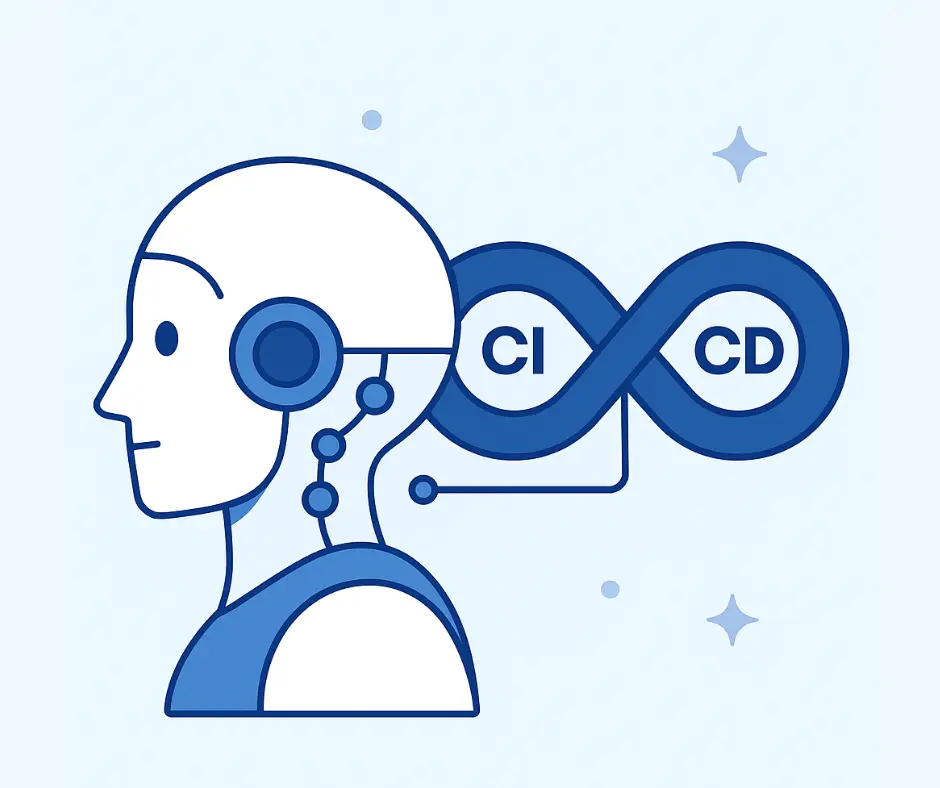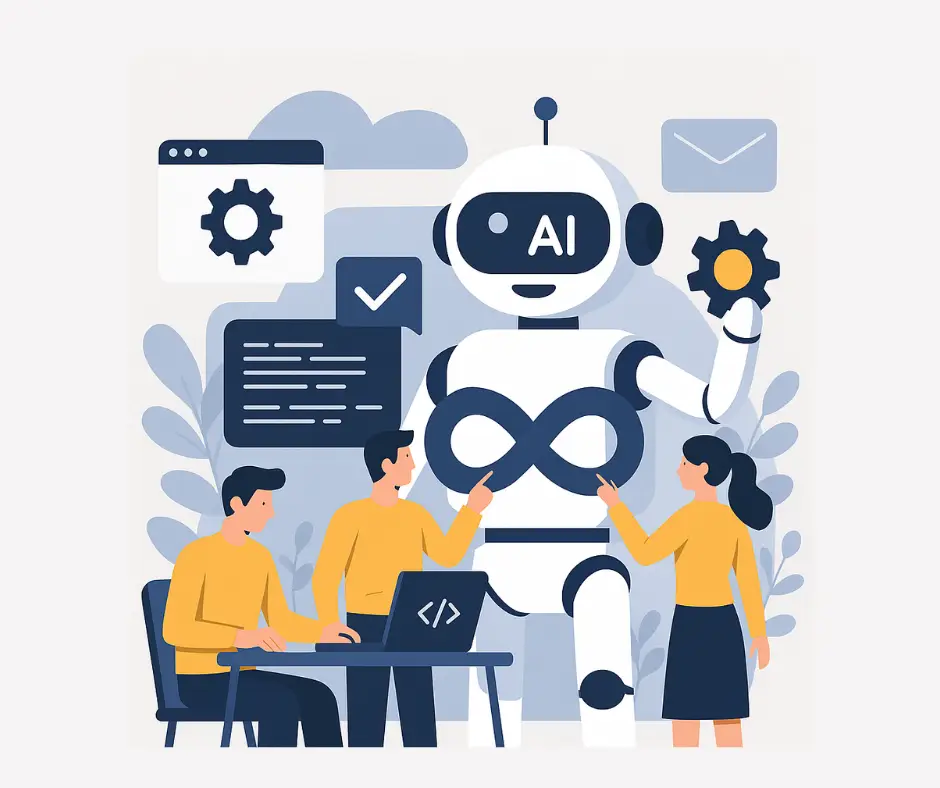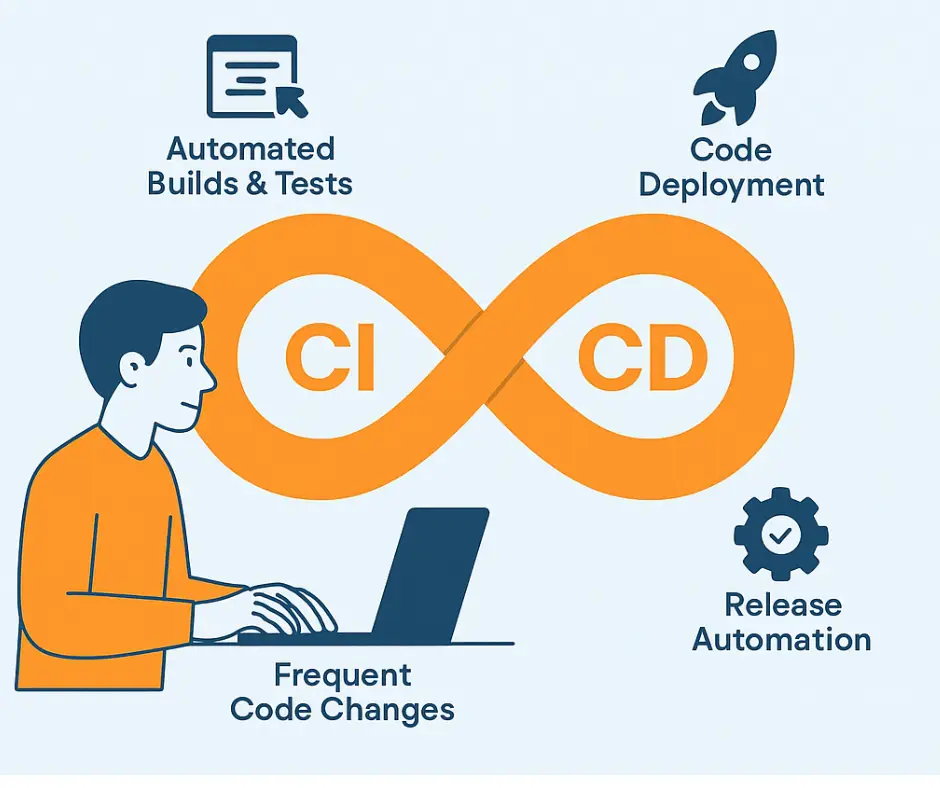
Everyone’s in a rush to automate more, deploy faster, and cut the noise. But speed without control leads to a mess. AI integration offers a solution-not as a perfect fix, but as a practical partner.
Especially when paired with tools developers already trust, like Jenkins and GitHub Actions. This combo changes the game from “run all the things” to “run the right things, at the right time, automatically.”
What Is AI Integration in Modern DevOps?
If DevOps is the engine, AI integration is the turbocharger.
You’re not just running builds and tests anymore. Now, you’re triaging failures in real time, skipping redundant tests automatically, predicting risks before they surface, and generating real feedback—effortlessly and in real time.
Modern AI-driven CI/CD tools analyze your commit history, learn from flaky test patterns, identify risky areas in your codebase, and help prioritize what really needs to be tested and when.
DevOps used to be reactive: run test, see red, investigate. Now, it’s proactive. AI suggests which tests to run, flags flaky tests before you even hit “Merge,” and knows which pipeline steps don’t need to run because nothing changed upstream.
And all of that happens inside your existing setup.
Test automation platform ZeuZ is already offering that. It brings AI-powered testing into workflows that cover everything from Web Automation and Mobile Automation to Desktop Automation, API Testing, and full-stack Performance Testing.
Why AI Integration Matters for CI/CD Pipelines

So what’s the real upside of adding AI into your CI/CD mix? Here’s what changes when AI get tightly integrated into your pipelines:
1. Build runs get smarter, not longer
Why run the whole suite if nothing changed in that part of the code? AI spots this in real-time and trims the fat. Instead of blindly re-running everything, you only run what’s relevant.
2. It catches bugs before you do
Historical test results, commit patterns, user journeys—AI crunches them all. It flags risky pull requests and brittle tests before your QA team even sees them.
3. Detect flaky tests and pattern failures
Tired of intermittent test failures that burn hours? Integration of AI means these issues can get flagged automatically, and it will suggest root causes. You can even isolate test environments with an AI platform like ZeuZ—all without manual tagging.
4. Dynamic resource optimization
Spin up parallel test runners only when needed. AI integration helps allocate, compute and scale intelligently during peak usage or large deployments.
5. Expand test coverage automatically
AI-powered automation generates tests based on real production activity, closing gaps that manual testing often misses. Some teams have seen test coverage go up by 35%, with zero added manual effort.
6. Speed up feedback loops
Waiting is time wasting. AI integration in the workflow allows developers to receive faster feedback. According to Atlassian’s 2025 DevEx report, 68% of developers now save 10+ hours per week using AI tools—up from 46% the year before.
7. Re-run only what matters
Did one line change in a shared component? AI knows which downstream tests are affected and re-runs those. Everything else? Left alone.
Key Benefits of AI Integration with Jenkins
Jenkins is the workhorse of CI. Flexible, widely adopted, and wildly extensible. But out of the box, it doesn’t think. It does. By introducing AI into the workflow, you can transform Jenkins from a tool that simply runs jobs into one that optimizes them. Here’s how AI integration enhances your setup without disrupting what already works:
1. Smarter job triggering
AI monitors commit history and patterns to determine which jobs actually need to run. Instead of running 15 pipelines on every PR, maybe it’s 4—and they’re the right ones.
2. Failure prediction and prevention
Let’s say a test fails intermittently based on timing or data state. Intelligent automation detects these patterns early, identifying instability before it causes another failure. That means cleaner builds, and better Test Reporting inside Jenkins dashboards.
3. Dynamic test selection
Jenkins paired with AI can automatically scope test cases based on what’s changed. Add Flow Control, and you can conditionally run blocks only when they matter.
4. Self-healing pipelines
Instead of breaking every time a UI element changes or an API response shifts slightly, AI-powered tools adapt on their own. This is a significant advantage when you’re handling Desktop Automation, API Testing, or even extensive Performance Testing suites via Jenkins.
5. Real-time optimization and insights
Over time, Jenkins pipelines become bloated. AI monitors job duration, historical success rates, bottlenecks, and even test relevance. You end up with a pipeline that’s lean, faster, and easier to debug.
How Integrating AI Enhances GitHub Actions

GitHub Actions is DevOps for people who don’t want to spend a weekend writing Groovy scripts. It’s elegant, easy to adopt, and integrates right into your code repository. But pair it with AI, and suddenly it’s less “nice automation” and more “how did we live without this?”
Here’s how that plays out:
1. Smarter runs, fewer wasted cycles
AI looks at the differences and knows what workflows need to run. Not based on guesswork, but on dependency graphs and actual behaviour patterns. You commit a doc fix, it skips the 45-minute test run. You push to a backend folder? It only runs backend tests. It’s like your workflows grew a brain.
2. Only the alerts that matter land in your inbox
We’ve all been there—20 notifications in Slack from your pipeline, and none of them are useful. With AI in the loop, you only get nudged when something’s genuinely off. Having an AI platform like ZeuZ in your workflow is like having a teammate who knows when to speak up and when to stay quiet.
3. Built-in optimization across jobs
It quietly tunes your workflows based on what’s been running slow or failing repeatedly. Parallel steps, caching strategies, runner allocation—all get sharper. You notice things are faster, but can’t quite pinpoint why. That’s the magic working behind the scenes.
4. Issues bubble up before anyone hits merge
AI integration enables you to spot regressions based on historical trends and recent code changes. It connects the dots between a subtle tweak and a potential outage. What used to take a team-wide standup to figure out, now gets flagged by a machine… in real-time. A real-world stat: teams using AI in CI pipelines see 85% faster defect detection.
5. Continuous learning
Every run improves the next one. GitHub Actions gets smarter over time—when AI is in the loop. Your failure patterns, flaky tests, and slow steps—all tracked and used to recommend cleaner workflows. Combine this with Flow Control features, and you’re flying.
Final Thoughts
Teams are now saving time, reducing test chaos, and moving faster without burning out. These became possible only because they prioritized AI integration.
If you’re serious about tightening your delivery loop, it’s time to stop doing it all manually. Try ZeuZ, explore how it can help you truly harness these benefits and automate smarter today.
